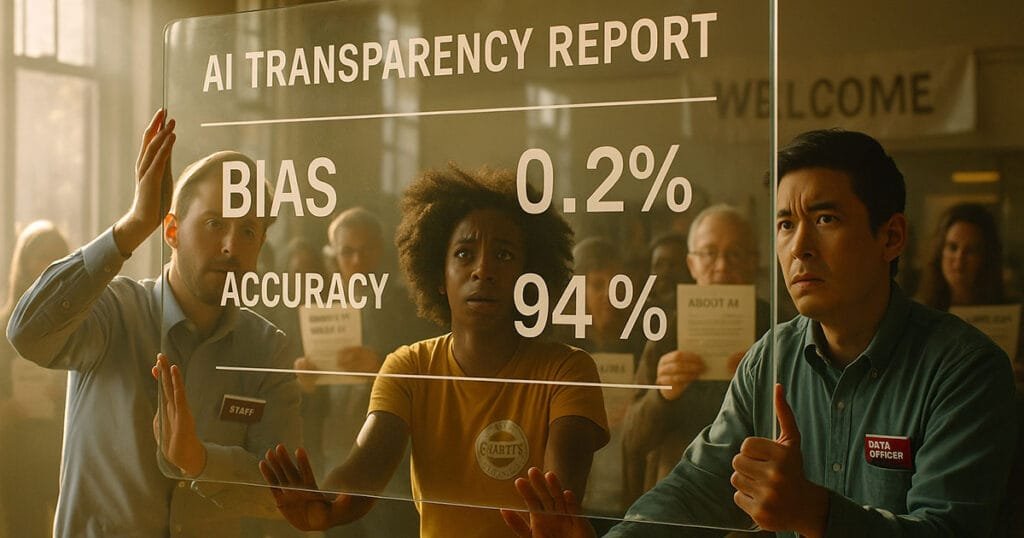TL;DR
UK charities can adopt AI ethics charity principles without risking trust by applying proportionate safeguards, documenting decisions, and being transparent with donors and beneficiaries. Start with safeguarding protocols, ensure data rights compliance, and maintain clear transparency standards.
The trust challenge facing UK charities today
The charity sector stands at a crossroads. AI tools promise significant efficiency gains and enhanced service delivery. Yet they also introduce risks that could undermine the very trust upon which charitable work depends. Unlike commercial organisations, charities operate under a unique duty of care. This extends beyond profit margins to encompass vulnerable beneficiaries, public accountability, and donor confidence.
Recent regulatory guidance makes clear that trustees cannot simply hope for the best when implementing AI systems. The Charity Commission guidance on AI risks explicitly flags AI risks to data security, copyright, and wider legal duties. It emphasises that charity trustees need to be confident they are acting prudently. This isn’t about avoiding innovation but about adopting it responsibly.
The stakes are particularly high for charities. A data breach or biased algorithm doesn’t just damage operational efficiency. It can destroy decades of community trust and jeopardise funding relationships. Recent research indicates that organisations adopting AI without proper governance face significantly higher incident rates than those with structured oversight. Yet with the right approach, charities can harness AI’s benefits whilst maintaining the ethical standards their supporters expect.

Why are AI ethics charity principles non-negotiable for UK organisations?
AI ethics charity standards protect beneficiaries, donors, and reputation, making clear rules and proportionate controls essential. Charity Commission guidance confirms that trustees remain fully accountable for decisions made by AI systems on their organisation’s behalf.
The regulatory landscape has shifted decisively towards active oversight rather than passive hope. Charity trustees increasingly prioritise AI governance at board level, recognising its importance for compliance and reputation management. “Trustees must act prudently; ethics are linked to compliance and reputation,” states recent Charity Commission guidance, making clear that responsible AI adoption isn’t optional.
The Digital Regulation Cooperation Forum’s 2024/25 workplan highlights cross-regulator focus on AI harms, signalling coordinated scrutiny across bodies that directly affect charities. Data protection complaints in the fundraising sector have risen substantially as automated decision-making becomes more widespread.
The ICO artificial intelligence guidance and toolkit provide practical controls to reduce risks to individuals’ rights. They establish clear requirements for lawful basis, fairness, and transparency. They also cover data protection impact assessments and testing procedures. These aren’t bureaucratic hurdles but essential safeguards. They protect both beneficiaries and organisational sustainability.
Trust remains the charity sector’s most valuable currency, and ethical AI adoption protects this asset whilst enabling innovation. For an overview of UK AI ethics requirements, see our complete guide to AI ethics in the UK.
Where do AI risks hit charities hardest?
Safeguarding vulnerabilities, donor trust erosion, biased service decisions, and weak supplier oversight create disproportionate harm for charitable organisations. Unlike commercial failures, charity AI mistakes directly affect vulnerable people who depend on fair treatment and accurate support.
The safeguarding dimension carries particular weight for charities serving children and vulnerable adults. Analysis of safeguarding incidents reveals that AI-related concerns often involve inappropriate automated responses to vulnerable individuals seeking support. “Bias testing and mitigation must be built into services and eligibility decisions,” emphasises the ICO’s fairness guidance, underlining how discrimination can creep into charitable decision-making.
New regulations reinforce safeguarding priorities. Ofcom’s Protection of Children code, finalised on 24 April 2025 with more than 40 safety measures, takes effect from 25 July 2025. This applies to services processing children’s data. The NSPCC’s January 2025 research identifies generative AI as creating emerging harms to children, calling for stronger protections across all youth-facing services.
Sector audits have highlighted bias risks in eligibility assessment tools, demonstrating the need for regular fairness evaluations. Donor trust represents another critical vulnerability; unlike customers who might switch providers after poor experiences, charitable supporters often make emotional commitments that, once broken, prove difficult to rebuild.
Supplier relationships add complexity. Many charities lack the technical expertise to assess AI vendors properly. Standard procurement processes often prove inadequate when evaluating algorithmic fairness, data security, or bias testing protocols.
These risks compound because charitable missions amplify the human cost of AI failures, making robust AI ethics charity safeguards essential rather than optional.

What do funders and regulators expect from responsible AI charity adoption today?
Funding bodies and oversight authorities demand clear safeguarding protocols, lawful data processing, systematic risk assessment, and transparent public communications. The National Lottery Community Fund expects grant holders to demonstrate a strong safeguarding culture and may withhold funding where policies are absent.
Major funding bodies have moved beyond general governance requirements to specific AI-related expectations. ACF members have signalled informally that clear AI governance boosts grant prospects. “Safeguarding is a grant condition requiring policies and incident response procedures,” states the National Lottery Community Fund’s guidance, making explicit that funding relationships depend on demonstrable AI governance.
Regulatory investigations into charity AI use have increased significantly, with oversight bodies taking a more active monitoring approach (Source: Charity Commission, 2024). The DRCF’s 2025/26 workplan, published in April 2025, deepens cross-regulator focus on AI assurance, transparency, and child-safety coordination, representing a shift from guidance towards active monitoring and enforcement.
Esmée Fairbairn Foundation requires safeguarding policies with all applications and publishes detailed policy guidance addressing digital services. The National Lottery Heritage Fund’s updated standard terms from January 2024 set explicit compliance and documentation duties covering AI adoption within funded projects.
Enforcement is becoming a reality rather than a threat. Ofcom’s “Year of Action” bulletin from May 2025 confirms that illegal-content and child-protection duties are now live and actively enforced. The ICO’s June 2025 speech commits to “certainty for organisations and stronger public safeguards,” reinforcing regulatory priorities around lawful basis and trusted AI governance.
Modern funding and regulatory relationships demand proactive compliance rather than reactive responses to problems. This makes structured AI governance essential for maintaining charitable operations.
How can charities implement responsible AI adoption quickly and effectively?
Begin with lightweight approaches: draft simple policies, document use cases, complete data protection assessments, deliver targeted training, and establish donor-facing transparency notices. The UK Government AI Playbook, published in February 2025, provides 10 principles and ready-made checklists designed for direct charity adaptation.
The Department for Science, Innovation and Technology’s AIME self-assessment offers structured approaches for organisations to evaluate core AI management practices. Charities using structured AI governance plans report fewer data-related incidents than those adopting tools without clear oversight (Source: Charity Digital, 2025). “Low-cost maturity checks help small charities align with UK policy direction,” notes the DSIT guidance, though many charities benefit from specialised support to navigate complex regulatory requirements effectively.
Role-based training modules of 30 minutes or less achieve high completion rates when tailored to specific job functions (Source: Institute of Fundraising, 2024). Practical implementation starts with five core actions: draft a concise AI policy covering acceptable use and risk assessment, create an AI register documenting tools and data processing, complete data protection impact assessments using ICO templates, deliver role-specific staff training, and publish donor-facing AI transparency notices.
Staff training need not be onerous. The ICO toolkit supports role-based learning through practical checklists covering data protection impact assessments, testing protocols, security measures, and rights compliance. Focus training on immediate roles, trustees need governance oversight, fundraisers need privacy compliance, and service staff need fairness and bias awareness.
Donor-facing transparency builds trust through clarity. The Fundraising Regulator’s code emphasises honesty and accessible privacy information, making transparency both ethical and compliant. Document decisions, test systems regularly, train people properly, and communicate openly with supporters.
These four pillars enable rapid yet responsible AI adoption that satisfies regulatory expectations whilst maintaining charitable values and donor confidence.

How does transparent AI adoption work in practice?
A mid-sized homelessness charity demonstrates effective, transparent AI adoption through its comprehensive approach to donor communications and service delivery. The organisation uses AI chatbots for initial housing enquiries, automated email personalisation for fundraising campaigns, and predictive analytics for resource allocation planning.
Their donor-facing AI notice explains each tool’s purpose in plain language. It details what personal data gets processed and outlines human oversight procedures. The charity publishes quarterly transparency reports showing AI decision accuracy rates, bias testing results, and service user feedback scores. This systematic approach enables efficient service delivery whilst maintaining donor confidence and regulatory compliance.
Staff training covers three levels: trustees receive quarterly governance briefings, frontline workers complete monthly fairness assessments, and fundraising teams attend bi-annual privacy compliance sessions. The charity maintains an AI register documenting every tool, its risk level, supplier details, and testing schedules.
When service users interact with AI systems, clear notices explain automated decision-making and provide easy access to human review. The organisation conducts monthly bias audits and publishes annual AI ethics reports demonstrating its commitment to responsible innovation.
This systematic approach enables the charity to leverage AI’s efficiency benefits whilst maintaining the transparency and accountability that donors expect. Their model shows how proportionate AI ethics charity implementation can enhance rather than hinder technological adoption.
Practical checklist for responsible AI adoption
Governance and policy: Establish trustee oversight for AI decisions and draft a concise AI acceptable use policy covering risk assessment, supplier evaluation, and escalation procedures.
Documentation and assessment: Create an AI register listing all tools, purposes, and risk levels. Complete data protection impact assessments for any AI processing personal data using ICO templates.
Training and competence: Deliver role-specific training: governance oversight for trustees, privacy compliance for fundraisers, and fairness awareness for service staff.
Transparency and communication: Publish donor-facing AI notices explaining tool usage, data processing, and safeguarding measures. Include AI information in privacy notices and supporter communications.
Testing and monitoring: Conduct regular bias testing, maintain supplier security assessments, and establish incident response procedures. Document all testing results and remedial actions.
Safeguarding integration: Embed AI considerations into existing safeguarding policies, ensure human oversight for vulnerable user interactions, and establish clear escalation procedures for sensitive situations.
The charity sector’s commitment to serving others creates natural alignment with ethical AI principles, making responsible adoption both achievable and sustainable. Need expert support implementing AI ethics and governance for your organisation?
This roadmap enables organisations of any size to adopt AI responsibly whilst maintaining regulatory compliance and donor trust. Success depends on proportionate implementation rather than perfect systems.
Your supporters expect transparency, your beneficiaries deserve protection, and your mission demands responsible innovation. The path forward combines regulatory compliance with charitable values, exactly what donors fund and communities need. For comprehensive guidance on AI adoption across all charity operations, see our Ultimate Guide to AI for Charities.

Your roadmap to trusted AI adoption
Responsible AI adoption for UK charities centres on proportionate safeguards that protect beneficiaries whilst enabling innovation. The regulatory direction is clear, funder expectations are rising, and practical tools for compliance are readily available through government guidance and regulator toolkits.
Start with documented approaches, systematic risk assessment, targeted staff training, and transparent supporter communications. The charity sector’s natural commitment to serving vulnerable communities aligns perfectly with ethical AI principles, making responsible adoption both practical and mission-consistent.




